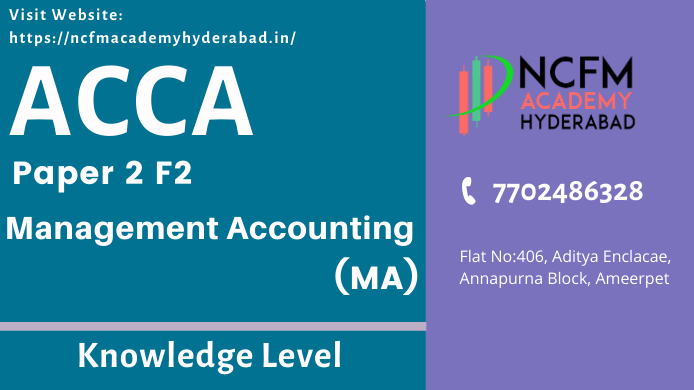Management in Accounting (MA) is the second exam you will be required to appear in. It is the second exam of the ACCA Foundation level where students will be required to develop management accounting techniques to help support businesses to plan, control and monitor their performance. Students will learn different methods of managing finance within a business organization with the aim of enhancing business performance. NCFM Academy Hyderabad, One of Leading Training center for Profissional Courses running F2 Management Accounting Course.
EXAM FORMAT of F2 Management Accounting
The syllabi of all foundation level exams are assessed by a two-hour-long computer-based examination. The syllabi as a whole are examinable; all of the questions in the exams will be compulsory which means that there is no topic that should be left out by the students during their preparation. The questions are designed in such a way that they test the knowledge, comprehension, and application of the knowledge acquired by the students.
Section A will contain 35 two mark objective test questions (OTs).
Section B will contain 3 ten mark multi-task questions (MCQs) each of which will examine Budgeting, Standard costing and Performance measurement sections of the syllabus
Syllabus of ACCA Paper F2 Management Accounting

The syllabus is divided into six sections with further sub-sections.
A- The nature, source, and purpose of management information
This is the first section of this course and it gives an introduction of cost and management accounting to the students. Students will learn the role and function of cost management, the need, and the importance of proper planning and control and why decision making is so important in business organizations. Students will learn the difference between different levels of planning in an organization.
This section will allow the students to understand the difference between information and data and why it is difficult for the management to provide appropriate information for the decision making process. Learning the difference between information and data will result in the students developing an understanding of different sources of data and the limitations they carry. Students will also be introduced to the concept of big data which will later be reintroduced in professional level examinations.
This section will also introduce the concept of costs and their classification and relation to various production activities and levels. The students will also be required to learn how to present information in a professional manner.
B- Data analysis and statistical techniques
Building upon the topics of the first section, the second section will teach students about sampling methods and their usefulness, statistical techniques for forecasting and analyzing data such as high /low method, scatter diagrams, regression analysis, coefficients, moving averages, time series an index number will be covered. Students will also be required to learn measures of central tendency and apply them in an analysis of financial data.
This section will also give an introduction to spreadsheets and their features which aid in data analysis, cost, and management accounting.
C- Cost accounting techniques.
This is the third section and it will introduce the students to cost accounting techniques. The students will learn about costs that are directly and indirectly attributable to the manufacturing process, how inventory is procured and maintained. Students will be introduced to the concept of stock control and cost-minimizing techniques for inventory management.
This section will also cover the concepts of absorption costing and marginal costing, students will be required to learn how to calculate contribution and the cost of inventory through both methods. Students will be further introduced to the concepts of the job order, batch costing and process costing. In addition to these methods, students will also be introduced to alternative cost accounting principles such as activity-based costing (ABC) and total quality management (TQM).
D- Budgeting
In the fourth section of this course, students will be introduced to the concept of budgeting. They will be required to understand the need and importance of budgeting for a business organization. Students will learn how budgets are planned, forecasted and controlled. Students will be introduced to differed types of budgets and budgeting techniques.
This section will also introduce the students to the concept of cash flow and the difference between cash flow and profits. Investment appraisal methods including net present value (NPV), internal rate of return (IRR) and payback methods will be introduced along with discounted cash flows and the calculation of present value and annuities. Students will be required to have a thorough understanding of these concepts, their application, and calculation.
Budgetary control techniques such as variance analysis will also be introduced in this section. Students will be required to understand the linkages between budgets, motivation, and organizational performance.
E- Standard costing
The fifth section of this course will build upon the last section where variances were introduced and the students will be required to learn and understand the concept of standard costing. Students will be required to understand and calculate, interpret and analyze sales, volume, labor, material, and overhead variances. Reconciliation of budgeted and actual profits is also included in this section.
F- Performance measurement
This is the final section of this course and it will focus on performance management. Students will be required to discuss and calculate different financial metrics including profitability ratios, liquidity ratios, activity ratios, and gearing ratios. Students will be introduced to the concept of the balanced scorecard, its advantages, and limitations. The concept of Critical Success Factors (CSF) will be introduced which will later be repeated in professional level exams.
Three E`s, economy, efficiency and effectiveness will be introduced and the students will be required to understand and explain the performance indicators linked with the 3E`s. Students will be given an overview and required to learn and understand the application of performance measurement concepts. This section will also cover cost reduction and value enhancement concepts and monitoring of performance and reporting.
